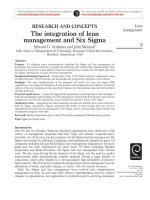The architecture of computer hardware and systems software an information technology approach ch02
Bạn đang xem bản rút gọn của tài liệu. Xem và tải ngay bản đầy đủ của tài liệu tại đây (225.09 KB, 43 trang )
CHAPTER 2:
Number Systems
The Architecture of Computer Hardware and
Systems Software:
An Information Technology Approach
3rd Edition, Irv Englander
John Wiley and Sons 2003
Why Binary?
Early computer design was decimal
John von Neumann proposed binary data processing (1945)
Mark I and ENIAC
Simplified computer design
Used for both instructions and data
Natural relationship between
on/off switches and
calculation using Boolean logic
Chapter 2 Number
Systems
On
Off
True
False
Yes
No
1
0
2-2
Counting and Arithmetic
Decimal or base 10 number system
Origin: counting on the fingers
“Digit” from the Latin word digitus meaning “finger”
Base: the number of different digits including zero in the number system
Example: Base 10 has 10 digits, 0 through 9
Binary or base 2
Bit (binary digit): 2 digits, 0 and 1
Octal or base 8: 8 digits, 0 through 7
Hexadecimal or base 16:
16 digits, 0 through F
Examples: 1010 = A16; 1110 = B16
Chapter 2 Number
Systems
2-3
Keeping Track of the Bits
Bits commonly stored and manipulated in groups
8 bits = 1 byte
4 bytes = 1 word (in many systems)
Number of bits used in calculations
Affects accuracy of results
Limits size of numbers manipulated by the computer
Chapter 2 Number
Systems
2-4
Numbers: Physical Representation
Different numerals, same number of
oranges
Cave dweller: IIIII
Roman: V
Arabic: 5
Different bases, same number of
oranges
510
1012
123
Chapter 2 Number
Systems
2-5
Number System
Roman: position independent
Modern: based on positional notation (place value)
Decimal system: system of positional notation based on powers of 10.
Binary system: system of positional notation based powers of 2
Octal system: system of positional notation based on powers of 8
Hexadecimal system: system of positional notation based powers of 16
Chapter 2 Number
Systems
2-6
Positional Notation: Base 10
43 = 4 x 101 + 3 x 100
10’s place
1’s place
Place
101
100
Value
10
1
4 x 10
3 x1
40
3
Evaluate
Sum
Chapter 2 Number
Systems
2-7
Positional Notation: Base 10
527 = 5 x 102 + 2 x 101 + 7 x 100
100’s place
1’s place
10’s place
Place
102
101
100
Value
100
10
1
5 x 100
2 x 10
7 x1
500
20
7
Evaluate
Sum
Chapter 2 Number
Systems
2-8
Positional Notation: Octal
6248 = 40410
64’s place
8’s place
1’s place
Place
82
81
80
Value
64
8
1
Evaluate
6 x 64
2x8
4x1
Sum for
Base 10
384
16
4
Chapter 2 Number
Systems
2-9
Positional Notation:
Hexadecimal
6,70416 = 26,37210
4,096’s place
256’s place
16’s place
Place
163
162
161
160
Value
4,096
256
16
1
6x
7 x 256
0 x 16
4x1
1,792
0
4
Evaluate
1’s place
4,096
Sum for
Base 10
24,576
Chapter 2 Number
Systems
2-10
Positional Notation: Binary
1101 01102 = 21410
Place
27
26
25
24
23
22
21
20
Value
128
64
32
16
8
4
2
1
1 x16
0x8
1x4
1x2
0x1
16
0
4
2
0
Evaluate
Sum for
Base 10
1 x 128 1 x 64 0 x 32
128
64
Chapter 2 Number
Systems
0
2-11
Estimating Magnitude: Binary
1101 01102 = 21410
1101 01102 > 19210 (128 + 64 + additional bits to the right)
Place
27
26
25
24
23
22
21
20
Value
128
64
32
16
8
4
2
1
0 x 32
1 x16
0x8
1x4
1x2
0x1
0
16
0
4
2
0
Evaluate
Sum for
Base 10
1 x 128 1 x 64
128
64
Chapter 2 Number
Systems
2-12
Range of Possible Numbers
R=B
where
R = range
B = base
K = number of digits
Example #1: Base 10, 2 digits
K
R = 102 = 100 different numbers (0…99)
Example #2: Base 2, 16 digits
R = 216 = 65,536 or 64K
16-bit PC can store 65,536 different number values
Chapter 2 Number
Systems
2-13
Decimal Range for Bit Widths
Bits
Digits
1
0+
4
1+
16 (0 to 15)
8
2+
256
10
3
16
4+
20
6
1,048,576 (1M)
32
9+
4,294,967,296 (4G)
64
19+
Approx. 1.6 x 1019
128
38+
Approx. 2.6 x 1038
Chapter 2 Number
Systems
Range
2 (0 and 1)
1,024 (1K)
65,536 (64K)
2-14
Base or Radix
Base:
The number of different symbols required to represent any given number
The larger the base, the more numerals are required
Base 10:
0,1, 2,3,4,5,6,7,8,9
Base 2:
0,1
Base 8:
0,1,2, 3,4,5,6,7
Base 16:
0,1,2,3,4,5,6,7,8,9,A,B,C,D,E,F
Chapter 2 Number
Systems
2-15
Number of Symbols
vs. Number of Digits
For a given number, the larger the base
but the fewer digits needed
Example #1:
the more symbols required
6516
10110
1458
110 01012
28410
4348
1 0001 11002
Example #2:
11C16
Chapter 2 Number
Systems
2-16
Counting in Base 2
Binary
Number
Equivalent
1’s (20)
Decimal
Number
0
0 x 20
0
1
1 x 20
1
8’s (23)
4’s (22)
2’s (21)
10
1 x 21
0 x 20
2
11
1 x 21
1 x 20
3
100
1 x 22
101
1 x 22
110
1 x 22
1 x 21
111
1 x 22
1 x 21
1000
1 x 23
1001
1 x 23
1010Chapter 2
1 Number
x 23
Systems
4
1 x 20
5
6
1 x 20
7
8
1 x 20
1 x 21
9
10 2-17
Base 10 Addition Table
310 + 610 = 910
+
0
1
2
3
4
5
6
7
8
9
0
0
1
2
3
4
5
6
7
8
9
1
1
2
3
4
5
6
7
8
9
10
2
2
3
4
5
6
7
8
9
10
11
3
3
4
5
6
7
8
9
10
11
12
4
4
5
6
7
8
9
10
11
12
13
etc
Chapter 2 Number
Systems
2-18
Base 8 Addition Table
38 + 68 = 118
+
0
1
2
3
4
5
6
7
0
0
1
2
3
4
5
6
7
1
1
2
3
4
5
6
7
10
2
2
3
4
5
6
7
10
11
3
3
4
5
6
7
10
11
12
4
4
5
6
7
10
11
12
13
5
5
6
7
10
11
12
13
14
6
6
7
10
11
12
13
14
15
7
7
10
11
12
13
14
15
16
Chapter 2 Number
Systems
(no 8 or 9,
of course)
2-19
Base 10 Multiplication Table
310 x 610 = 1810
x
0
1
2
0
3
4
5
6
7
8
9
0
1
1
2
3
4
5
6
7
8
9
2
2
4
6
8
10
12
14
16
18
3
3
6
9
12
15
18
21
24
27
4
8
12
16
20
24
28
32
36
5
5
10
15
20
25
30
35
40
45
6
6
12
18
24
30
36
42
48
54
7
7
14
21
28
35
42
49
56
63
4
0
Chapter 2 Number
Systems
etc.
2-20
Base 8 Multiplication Table
38 x 68 = 228
x
0
1
2
0
3
4
5
6
7
0
1
1
2
3
4
5
6
7
2
2
4
6
10
12
14
16
3
6
11
14
17
22
25
4
4
10
14
20
24
30
34
5
5
12
17
24
31
36
43
6
6
14
22
30
36
44
52
7
7
16
25
34
43
52
61
3
0
Chapter 2 Number
Systems
2-21
Addition
Base
Problem
Largest Single Digit
Decimal
6
+3
9
Octal
6
+1
7
Hexadecimal
6
+9
F
Binary
1
+0
1
Chapter 2 Number
Systems
2-22
Addition
Base
Problem
Carry
Answer
Decimal
6
+4
Carry the 10
10
Octal
6
+2
Carry the 8
10
Hexadecimal
6
+A
Carry the 16
10
Binary
1
+1
Carry the 2
10
Chapter 2 Number
Systems
2-23
Binary Arithmetic
1
1
1
1
1
+
1
0
0
Chapter 2 Number
Systems
1
1
0
1
1
0
1
1
0
1
1
0
0
0
0
1
1
2-24
Binary Arithmetic
Addition
Multiplication
Boolean using XOR and AND
+
0
1
AND
Shift
Division
x
0
1
Chapter 2 Number
Systems
0
1
0
1
1
10
0
1
0
0
0
1
2-25









